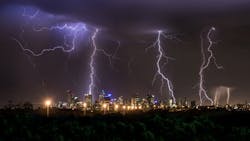How Lightning Affects Your Electrical System
Transient overvoltages can cripple an electrical system, causing critical component failure and potentially igniting a fire in your facility. There are two categories of transient overvoltages: impulsive and oscillatory. The focus of this article is impulsive transient overvoltages.
Impulsive transients are frequently caused by lightning striking the electric utility’s transmission or distribution system, the earth nearby, or a facility directly. An impulsive transient is defined as a very fast (typically microseconds) change in the nominal voltage with a sharp rise of ~2.5 pu followed by a fast decay to nominal voltage. An approximate 2.5 pu rise in voltage equals 1,696Vpeak for a 480V nominal system. This spike in voltage is high enough to destroy electrical and electronic equipment that’s been left unprotected in your facility.
Some areas of North America are more prone to lightning strikes than others. The facilities in these high strike zones are typically hardened to protect against damage. However, much of North America has neglected to address the topic of lightning because it rarely occurs in many regions.
Whether the lightning strikes the conductors of the power lines or the earth near its supporting structure, the effects are similar. A direct strike on the electric utility distribution system will typically cause a flashover, followed by a voltage sag and possible outage. If the strike is to earth, the high voltage can induce an impulsive transient on the powerline conductors. Either way, the rise in voltage is high enough to damage equipment.
Impulsive transients can also enter a facility through its “back door.” The back door is often completely missed in protection schemes. So, what is this back door? A facility has more than one conductive path coming into the building. In addition to the electrical utility service cabling, phone, data, and cable service pathways can also be impacted by a direct lightning strike or induced voltage from an earth strike. There have been numerous building fires traced to telephone, networking, or cable system pathways in a building. Not only is properly sized surge protection necessary, but it is also imperative that proper bonding and grounding is completed at these back door locations, as required by the National Electrical Code (NEC). When failures and fires occur inside a facility due to a transient overvoltage, deficiencies in intersystem bonding are typically identified as the contributing cause. That’s why it’s important to consult NEC Art. 250 and Art. 800 for more information on proper intersystem bonding.About the Author
Bryan Glenn
Power Quality Consultant
Bryan Glenn is a power quality consultant for EC&M magazine. He can be reached at [email protected].
